#Annie Chapman
Text

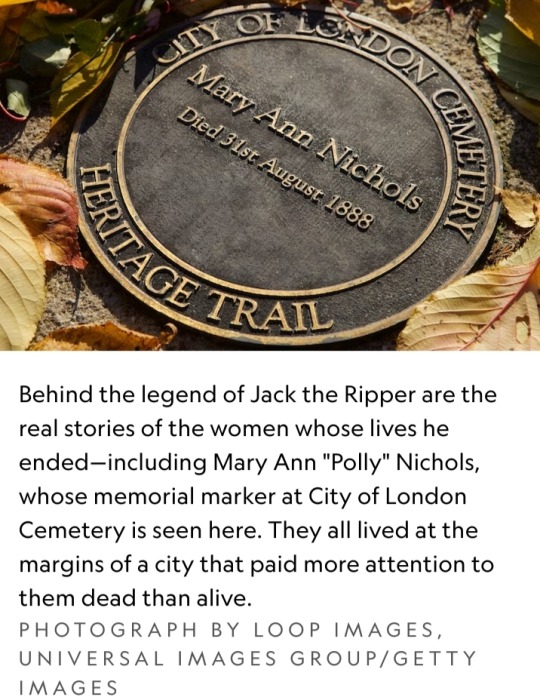
By Parissa DJangi
August 18, 2023
Some say he was a surgeon. Others, a deranged madman — or perhaps a butcher, prince, artist, or specter.
The murderer known to history as Jack the Ripper terrorized London 135 years ago this fall.
In the subsequent century, he has been everything to everyone, a dark shadow on which we pin our fears and attitudes.
But to five women, Jack the Ripper was not a legendary phantom or a character from a detective novel — he was the person who horrifically ended their lives.
“Jack the Ripper was a real person who killed real people,” reiterates historian Hallie Rubenhold, whose book, The Five, chronicles the lives of his victims. “He wasn’t a legend.”
Who were these women? They had names: Mary Ann “Polly” Nichols, Annie Chapman, Elizabeth Stride, Catherine Eddowes, and Mary Jane Kelly.
They also had hopes, loved ones, friends, and, in some cases, children.
Their lives, each one unique, tell the story of 19th-century London, a city that pushed them to its margins and paid more attention to them dead than alive.
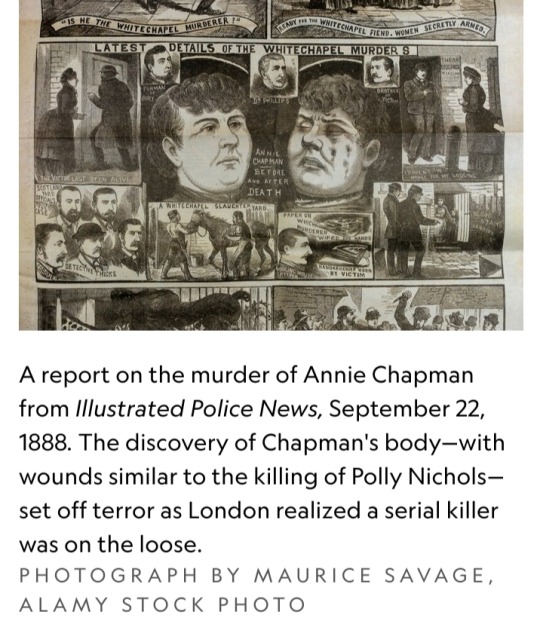
Terror in Whitechapel
Their stories did not all begin in London, but they ended there, in and around the crowded corner of the metropolis known as Whitechapel, a district in London’s East End.
“Probably there is no such spectacle in the whole world as that of this immense, neglected, forgotten great city of East London,” Walter Bessant wrote in his novel All Sorts and Conditions of Men in 1882.
“It is even neglected by its own citizens, who had never yet perceived their abandoned condition.”
The “abandoned” citizens of Whitechapel included some of the city’s poorest residents.
Immigrants, transient laborers, families, single women, thieves — they all crushed together in overflowing tenements, slums, and workhouses.
According to historian Judith Walkowitz:
“By the 1880s, Whitechapel had come to epitomize the social ills of ‘Outcast London,’ a place where sin and poverty comingled in the Victorian imagination, shocking the middle classes."
Whitechapel transformed into a scene of horror when the lifeless, mutilated body of Polly Nichols was discovered on a dark street in the early morning hours of August 31, 1888.
She became the first of Jack the Ripper’s five canonical victims, the core group of women whose murders appeared to be related and occurred over a short span of time.


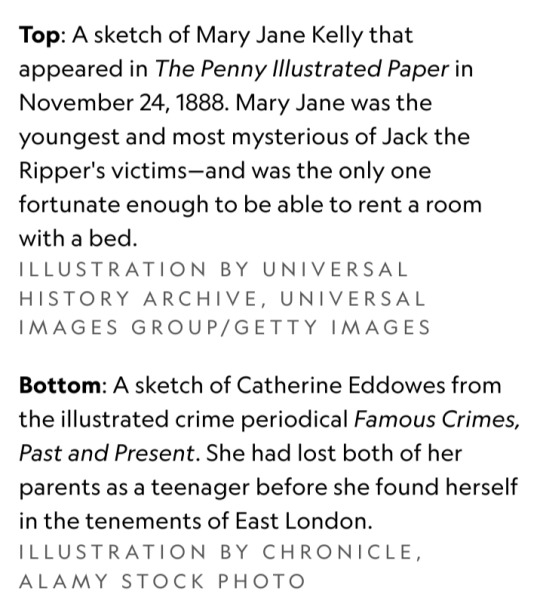
Over the next month, three more murdered women would be found on the streets of the East End.
They had been killed in a similar way: their throats slashed, and, in most cases, their abdomens disemboweled.
Some victims’ organs had been removed. The fifth murder occurred on November 9, when the Ripper butchered Mary Jane Kelly with such barbarity that she was nearly unrecognizable.
This so-called “Autumn of Terror” pushed Whitechapel and the entire city into a panic, and the serial killer’s mysterious identity only heightened the drama.
The press sensationalized the astonishingly grisly murders — and the lives of the murdered women.
Polly, Annie, Elizabeth, Catherine, and Mary Jane
Though forever linked by the manner of their death, the five women murdered by Jack the Ripper shared something else in common:
They were among London’s most vulnerable residents, living on the margins of Victorian society.
They eked out a life in the East End, drifting in and out of workhouses, piecing together casual jobs, and pawning their few possessions to afford a bed for a night in a lodging house.
If they could not scrape together the coins, they simply slept on the street.
“Nobody cared about who these women were at all,” Rubenhold says. “Their lives were incredibly precarious.”
Polly Nichols knew precarity well. Born in 1845, she fulfilled the Victorian ideal of proper womanhood when she became a wife at the age of 18.
But after bearing five children, she ultimately left her husband under suspicions of his infidelity.
Alcohol became both a crutch and curse for her in the final years of her life.

Alcohol also hastened Annie Chapman’s estrangement from what was considered a respectable life.
Annie Chapman was born in 1840 and spent most of her life in London and Berkshire.
With her marriage to John Chapman, a coachman, in 1869, Annie positioned herself in the top tier of the working class.
But her taste for alcohol and the loss of her children unraveled her family life, and Annie ended up in the East End.
Swedish-born Elizabeth Stride was an immigrant, like thousands of others who lived in the East End.
Born in 1843, she came to England when she was 22. In London, Stride reinvented herself time and time again, becoming a wife and coffeehouse owner.
Catherine Eddowes, who was born in Wolverhampton in 1842 and moved to London as a child, lost both of her parents by the time she was 15.
She spent most of her adulthood with one man, who fathered her children. Before her murder, she had just returned to London after picking hops in Kent, a popular summer ritual for working-class Londoners.
At 25, Mary Jane Kelly was the youngest, and most mysterious, of the Ripper’s victims.
Kelly reportedly claimed she came from Ireland and Wales before settling in London.
She had a small luxury that the others did not: She rented a room with a bed. It would become the scene of her murder.
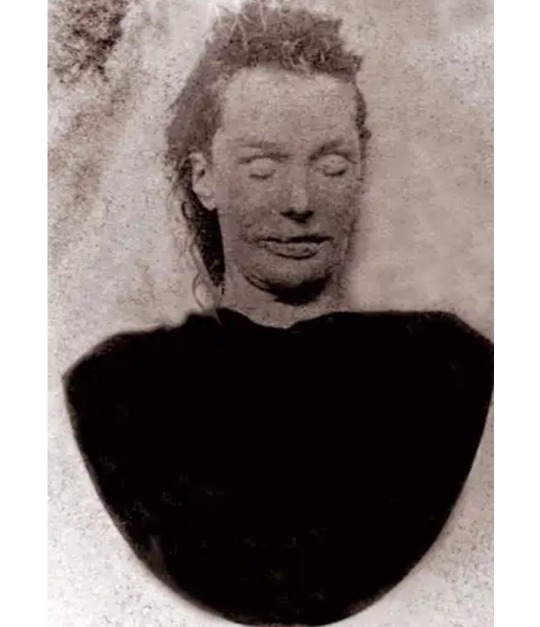
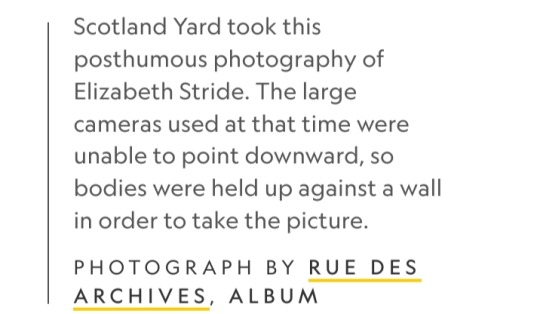
Yet the longstanding belief that all of these women were sex workers is a myth, as Rubenhold demonstrates in The Five.
Only two of the women — Stride and Kelly — were known to have engaged in sex work during their lives.
The fact that all of them have been labeled sex workers highlights how Victorians saw poor, unhoused women.
“They have been systematically ‘othered’ from society,” Rubenhold says,"even though this is how the majority lived.”
These women were human beings with a strong sense of personhood. According to biographer Robert Hume, their friends and neighbors described them as “industrious,” “jolly,” and “very clean.”
They lived, they loved, they existed — until, very suddenly on a dark night in 1888, they did not.
A long shadow
The discovery of Annie Chapman’s body on September 8 heightened panic in London, since her wounds echoed the shocking brutality of Polly Nichols’ murder days earlier.
Investigators realized that the same killer had likely committed both crimes — and he was still on the loose. Who would he strike next?
In late September, London’s Central News Office received a red-inked letter that claimed to be from the murderer. It was signed “Jack the Ripper.”
Papers across the city took the name and ran with it. Press coverage of the Whitechapel Murders crescendoed to a fever pitch.
Newspapers danced the line between fact and fiction, breathlessly recounting every gruesome detail of the crimes and speculating with wild abandon about the killer’s identity.
Today, that impulse endures, and armchair detectives and professional investigators alike have proposed an endless parade of suspects, including artist Walter Sickert, writer Lewis Carroll, sailor Carl Feigenbaum, and Aaron Kosminski, an East End barber.
"The continued fascination with unmasking the murderer perpetuates this idea that Jack the Ripper is a game,” Rubenhold says.
She sees parallels between the gamification of the Whitechapel Murders and the modern-day obsession with true crime.
“When we approach true crime, most of the time we approach as if it was legend, as if it wasn’t real, as if it didn’t happen to real people.”
“These crimes still happen today, and we are still not interested in the victims,” Rubenhold laments.
The Whitechapel Murders remain unsolved after 135 years, and Rubenhold believes that will never change:
“We’re not going to find anything that categorically tells us who Jack the Ripper is.”
Instead, the murders tell us about the values of the 19th century — and the 21st.

#Jack the Ripper#Hallie Rubenhold#The Five#Mary Ann “Polly” Nichols#Annie Chapman#Elizabeth Stride#Catherine Eddowes#Mary Jane Kelly#19th-century#1800s#Whitechapel#London#Walter Bessant#Judith Walkowitz#Outcast London#East End#Autumn of Terror#Victorian society#Victorian era#Robert Hume#1888#Central News Office#Whitechapel Murders#Whitechapel Murderer#Leather Apron#murder#crime#mystery#unsolved case#National Geographic
75 notes
·
View notes
Text

ANNIE CHAPMAN
Annie Chapman, 47 years old. On Saturday 8 September 1888 the body of Annie Chapman was discovered at about 6a.m. near the steps to the rear courtyard entrance of 29 Hanbury Street in Whitechapel. John Pizer was arrested for this murder, nicknamed until his identification as Leather Apron was exonerated the next day, when it was discovered that the apron belonged to a tenant of the building where the murder had been committed, which had been washed and hung up to dry. The killer remained unknown and the police had to suspects: they assumed he was either a fanatical lunatic or a sexual maniac with some moderate knowledge of anatomy.
4 notes
·
View notes
Text
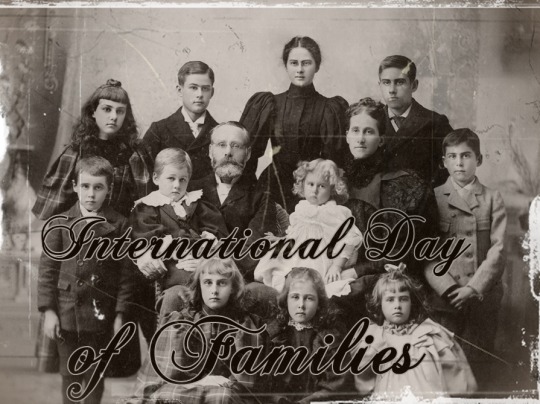
The International Day of Families is observed on 15 May every year. The Day was proclaimed by the UN General Assembly in 1993 and reflects the importance the international community attaches to families. The International Day provides an opportunity to promote awareness of issues relating to families and to increase knowledge of the social, economic and demographic processes affecting families.
In human society, family (from Latin: familia) is a group of people related either by consanguinity (by recognized birth) or affinity (by marriage or other relationship). The purpose of the family is to maintain the well-being of its members and of society. Ideally, families offer predictability, structure, and safety as members mature and learn to participate in the community. In most human societies, the family is the primary locus of attachment, nurturance, and socialization.
The women victims of brutal attacks in and or around London’s Whitechapel area between 1873 and 1891 were daughters, granddaughters, nieces, aunties, mothers, grandmothers, cousins... Here's a list of all their known relatives:
Annie Smith Chapman:
Parents and siblings: Daughter of George Smith and Ruth (née Chapman). Older sister of Emily Latitia (b. 1844), George William Thomas (c. 2nd June 1844 ~ d. June 1854), Miriam (c. 25th January 1852 ~ d. June 1854), William (c. 1st February 1854 ~ d. June 1854), Georgina (b.1856), Mirium Ruth (b.1858), and Fountain Hamilton (b. 1861).
Husband and children: Married John Chapman (1869 – 1884). Mother of Emily Ruth (b. 25 June 1870 - d. ca. 1882), Annie Georgina (b. 5 June 1873), John Alfred (b. 21 November 1880).
Extended family: Uncle Thomas Smith. Daughter-in-law of George and Ann Chapman.
Catherine Eddowes
Parents and siblings: Daughter of George Eddowes and Catherine (née Evans). Younger sister of Alfred (c. 2nd August 1833), Harriet (c. 3rd October 1834), Emma (b. 30th November 1835), Eliza Gold (c. 14th May 1837) and Elizabeth Fisher (b. 1838). Older sister of Thomas (b. 9th December 1844), George (b. 1846 – d. 1885), John (b. January 1849 – d. 18th March 1849), Sarah Ann (b. 1850), Mary Ann (b. 1852) and William (b. 1854 – d. 1854).
Husband and children: Had a relatioship with Thomas Conway (1862 – 1881). Mother of Catherine Ann "Annie" (b. 18 April 1863), Thomas Lawrence (b. 8 December 1867), George (b. 15 August 1873), Frederick William (b. 21 February 1877). Common-law wife of John Kelly (1881 – 1888, her murder).
Extended family: Uncle William Eddowes, uncle Thomas Eddowes, aunt with unknown name, paternal grandfather Thomas Eddowes. More ancestors can be found here. Son in law was Louis Phillips (married to daughter Annie). Her great-great-great-grandaughter is Jean Smith and her daughter is Tracey Marks.
Emma Elizabeth Smith
Children: A son and a daughter.
Elizabeth Gustaffsdotter Stride
Parents and siblings: Daughter of Gustaf Ericsson and Beatta Carlsdotter. Younger sister of Anna Christin (b. 1840), older sister of Carl Bernard (b. 1848) and Svante (b.1851).
Husband and children: She gave birth to a stillborn daughter result of her 7th month pregnancy (21 April 1865). She married John Thomas William Stride (1869 – 1881) and the couple had no children.
Extended family: Daughter-in-law of William Stride and Elenor Monk Stride. Her husband had 8 more siblings. PC Walter Stride was her nephew by marriage. Her sister-in-law was Olena, married to her brother Carl Bernard; and her brother-in-law was Bernhard Olsson. Descendants relatives are John and Sally Edmonds (Sally is related to John Stride).
Alice Pitts McKenzie
Parents and siblings: Daughter of Charles Pitts and Martha (neé Watson). Younger sister of William (b. 1833), John (b. 1838), Martha (b. 1840) and Jane (b. 1843), older sister of Charles (b. 1847) and Thomas (b. 1850).
Husband and children: Married to Joseph Kinsey (1863 – 1867, his death). Mother of Joseph James Kinsey (b. 21 July 1866 – d. 12 October 1866). She was in a relatioship with John McCormack (1883 – 1889, her murder).
Mary Ann Walker Nichols
Parents and siblings: Daughter of Edward and Caroline Walker. Sister of Frederick and Edward Jr. One of them died on June 1886.
Husband and children: Wife of William Nichols (1861 – 1881). Mother of William Edward (b. 17 December 1864 – d. 1866), Edward John (b. 14 July 1866), Percy George (b. 18 July 1868), Alice Esther (b. December 1870), Eliza Sarah (b. December 1876), Henry Alfred (b. 4 December 1878).
Extended family: Her maternal aunt was Mary Webb. Maureen Nichols is a descendant.
Martha White Tabram
Parents and siblings: Daughter of Charles Samuel White and Elisabeth (neé Dowsett). Younger sister of Sarah Elizabeth (b. 1832), Henry (b. 1837), Esther (b. 1839), Stephen (b. 1842) and Mary Ann (b. 1847).
Husband and children: Married to Henry Samuel Tabram (1865 – 1875). Mother of Frederick John (b. February 1871) and Charles Henry (b. December 1872). Had a relationship with Henry Turner (1876 – 1888).
Extended family: Her parents-in-law were John and Hannah Tabram. Her sisters-in-law were Anna or Hannah and Mary, and her brothers-in-law were Thomas and William (Mary, Thomas and William Tabram were triplets). She has a step-son, Henry, from Henry Samuel's first marriage to Mathilda.
Frances Coles
Parents and siblings: She was the daughter of James William Coles and Mary Ann (née Carney). Her older sisters were Mary Ann (b. ca. 1853) and Selina Adelina (b. 25th October 1855 – d. 1897), and her youngerbrother was and James Jr. (b. 30th August 1862 – d. ca. 9th January 1889).
Extended family: Baby niece Selina Adelina (b. and d. 1877), daughter of her sister Selina.
Rose Mylett
Parents and siblings: Daughter of Henry Mylett and Margaret (nee Haley). Younger sister of Mary (b. 1855) and William (b. 1857), older sister of John (b. 1863).
Husband and children: Common-law wife of Thomas Davis (c. 1880 ~ 1883). Mother of Florence Beatrice "Flossie", "Florrie" (b. 22 October 1880), and Henry (b. 29 June 1883 – may had died in infancy).
Emily Atkins Horsnell
Parents and siblings: Unfortunately itis not known at the moment the names of Emily Atkins parents. She had a sister, Mrs. Ekins.
Husband and children: Emily was married to Alfred Horsnell (1880 – before 1886). She was the mother of Emily Horsnell (b. 1881).
Mary Kelly
Parents and siblings: Daughter of John Kelly. She had seven brothers (one of them called Henry) and at least one sister (not known if older or younger).
Husband and children: Married to a man with surname Davies (1879 ~ 1881, his death). They had no children.
Ada Elbury Wilson
Parents and siblings: Daughter of Henry Edwin Elbury and Emma (née Fry). She was the sister of Charles and Henry (don't know if older or younger), and the older sister of Rose, Emma and Thomas.
Husband and children: Ada married Samuel Wilson (1889 – 1891) and it is not known if they had children.
Extended family: A niece named Zoa Lavinia Elbury, daughter of her brother Henry.
Elizabeth Jackson
Parents and siblings: Daughter of John and Catherine Jackson. Younger sister of Annie and May, sister of James (not known if older or younger).
Husband and children: She was in a relatioship with John Fairclough (1888 – 1889, her murder) and was murdered when she was eight months pregnant.
#International Day of Families#Special dates#family#victims#19th century#victorian women#violence against women#Annie Chapman#Catherine Eddowes#Elizabeth Stride#Mary Ann nichols#Alice McKenzie#Martha Tabram#Frances Coles#Rose Mylett#Emily Horsnell#Mary Kelly#Ada Wilson#Elizabeth Jackson#women's history#history of women#father#mother#sibling#brother#sister#wife#husband#relationship#child
12 notes
·
View notes
Text
Watch "Javi and Izzy Brother Sister Song" on YouTube
youtube
Here is my Javi and Izzy Video and they are one of my favorite sibling relationships in TV shows.
#power rangers dino fury#youtube#javi garcia#izzy garcia#steve chapman#annie chapman#brother sister song#step siblings
3 notes
·
View notes
Text
Book Review - The Five: The Untold Lives of The Women Killed by Jack the Ripper (Halle Rubenhold)
Book Review – The Five: The Untold Lives of The Women Killed by Jack the Ripper (Halle Rubenhold)
In an essay written in 1946 George Orwell claimed that there’s nothing the English like more than a decent murder:
It is Sunday afternoon, preferably before the war. The wife is already asleep in the armchair, and the children have been sent out for a nice long walk. You put your feet up on the sofa, settle your spectacles on your nose, and open the News of the World. Roast beef and Yorkshire,…
View On WordPress
#19th century British History#Annie Chapman#Catherine Eddowes#Elizabeth Stride#George Orwell#Halle Rubenhold#Hillary Mantel#Jack the Ripper#Mary Jane Kelly#Polly Nichols#Prince Albert Victor Duke of Clarence
2 notes
·
View notes
Text
Jack the Ripper and Abraham Lincoln - by Tony McMahon
For two years, I’ve been investigating the Jack the Ripper case – pouring over the original police and court records, as well as contemporary newspaper reports and other evidence. What I’ve uncovered will amaze you. On May 28, 2024 – I will reveal all in a new book: Jack the Ripper and Abraham Lincoln (Troubador publishing).
The spark for this investigation was an appearance on the documentary…

View On WordPress
#Abraham Lincoln#Annie Chapman#Francis Tumblety#jack the ripper and abraham Lincoln#Jack the Ripper Tony McMahon#TV historian Tony McMahon
0 notes
Text
Jack the Ripper and Abraham Lincoln - by Tony McMahon
For two years, I’ve been investigating the Jack the Ripper case – pouring over the original police and court records, as well as contemporary newspaper reports and other evidence. What I’ve uncovered will amaze you. On May 28, 2024 – I will reveal all in a new book: Jack the Ripper and Abraham Lincoln (Troubador publishing).
The spark for this investigation was an appearance on the documentary…

View On WordPress
#American suspect Ripper#Annie Chapman#death#Francis Tumblety#history#Jack the Ripper 1888#jack the Ripper tumblety#London#Mary Kelly#Ripper Tony mcmahon#TV historian Tony McMahon
0 notes
Text
Jack the Ripper and Abraham Lincoln - by Tony McMahon
For two years, I’ve been investigating the Jack the Ripper case – pouring over the original police and court records, as well as contemporary newspaper reports and other evidence. What I’ve uncovered will amaze you. On May 28, 2024 – I will reveal all in a new book: Jack the Ripper and Abraham Lincoln (Troubador publishing).
The spark for this investigation was an appearance on the documentary…

View On WordPress
#American suspect Ripper#Annie Chapman#death#Francis Tumblety#history#Jack the Ripper 1888#jack the Ripper tumblety#London#Mary Kelly#Ripper Tony mcmahon#TV historian Tony McMahon
0 notes
Text
‘On the Trail of Jack the Ripper’ by Richard Charles Cobb
‘On the Trail of Jack the Ripper’ by Richard Charles Cobb
Genre: Adult Non-Fiction – True Crime
Published: 2022
Format: Paperback
Rating: ★★★★
I’ve had a fascination with the Jack the Ripper mystery for years. Well, unsolved mysteries generally which started with the disappearance of the Princes in the Tower, and the death of Amy Robsart. But the Jack the Ripper mystery is a lot gorier and more disturbing.
This book discusses the five canonical…
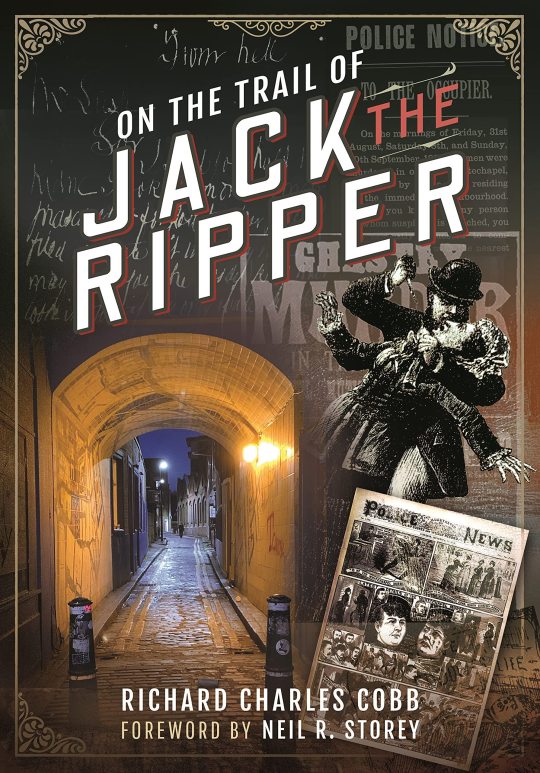
View On WordPress
#Annie Chapman#Catherine Eddowes#Crime#Elizabeth Stryde#History#Jack the Ripper#liz stryde#mary ann nichols#Mary Jane Kelly#Murder#mutilation#neil r storey#Non Fiction#Pen and Sword#Polly Nichols#richard charles cobb#ripper#Serial Killer#True Crime#unsolved#unsolved murders
0 notes
Video
youtube
I made a karaoke for my favourite song from my favourite underrated musical <3
#get jack#get jack a killer musical#get jack musical#forever erased#annie chapman#this song makes me cry#every time#god it's so beautiful
0 notes
Video
youtube
Ruby Gillman, Teenage Kraken Trailer
Ruby Gillman is desperate to fit in at Oceanside High. She tutors her crush in math, but he doesn’t seem interested in her otherwise, and she can’t hang out with the cool kids at the beach because her mom forbade her from ever getting in the water. One day, though, Ruby breaks her mom’s rule and discovers that she is a descendant of warrior Kraken queens and is destined to inherit the throne from her grandmother, the Warrior Queen of the Seven Seas. For eons Krakens protect the oceans from the power-hungry Mermaids. To make matters worse, Chelsea, the new popular girl at Oceanside High, is a mermaid. “Ruby will ultimately need to embrace who she is and go big to protect those she loves most.” (Universal Pictures)
DreamWorks Animation’s Ruby Gillman, Teenage Kraken stars Lana Condor (Ruby Gillman), Jaboukie Young-White, Toni Collette, Jane Fonda, Annie Murphy, Colman Domingo, Sam Richardson, and Blue Chapman. Kirk DeMicco directs.
Ruby Gillman, Teenage Kraken hits theaters in Summer 2023.
#ruby gillman teenage kraken#ruby gillman#teenage kraken#lana condor#jaboukie young white#toni collette#jane fonda#annie murphy#colman domingo#sam richardson#blue chapman#kirk demicco#dreamworks#universal pictures#TGCLiz
95 notes
·
View notes
Text




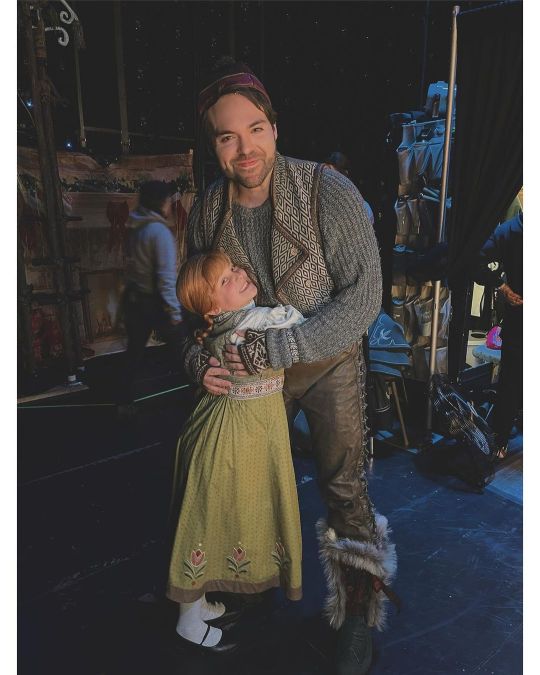
frozen north american tour incredibly blessed
#alexander mendoza#annie piper braverman#erin yoonsuh choi#lauren nicole chapman#kristoff#anna#princess anna#elsa#princess elsa#elsanna#instagram#behind the scenes#disney#frozen#broadway#frozen broadway#frozen the musical#north american tour
11 notes
·
View notes
Text
having Tracy Chapman, Julien Baker AND Annie Lennox at the 2024 grammys is such a win for butch women everywhere
14 notes
·
View notes
Text
TRACY CHAPMAN I LOVE YOU
#literally only thing that matters from the grammy’s#+ annie lenox calling for a ceasefire obvs that’s the most important#jasmine has thoughts#tracy chapman
10 notes
·
View notes
Text
Watch "Sam and Anthony Brother Sister Song" on YouTube
youtube
Here is my first video for another one of my favorite siblings relationship on a TV show and Sam is the older sister of Anthony.
#youtube#cobra kai#sam larusso#anthony larusso#steve chapman#annie chapman#brother sister song#oldersister#youngerbrother
1 note
·
View note
Photo

Ruby Gillman, Teenage Kraken (2023)
This is a Movie Health Community evaluation. It is intended to inform people of potential health hazards in movies and does not reflect the quality of the film itself. The information presented here has not been reviewed by any medical professionals.
Ruby Gillman, Teenage Kraken has several scenes with harsh flickering lights, mostly happening in moments of high stress or peril.
There are scenes following action underwater at high speeds and through barrel roll maneuvers.
Flashing Lights: 9/10. Motion Sickness: 5/10.
TRIGGER WARNING: Visceral panic attacks are depicted.
NOTE: Our evaluation of Indiana Jones and the Dial of Destiny is now available on our Patreon page at Patreon.com/MovieHealth, and will be available on this page on Tuesday, July 4
Image ID: A promotional poster for Ruby Gillman, Teenage Kraken
#Movie Health Community#Health Warning#Actually Epileptic#Photosensitive Epilepsy#Seizures#Migraines#Motion Sickness#Dreamworks#Ruby Gillman Teenage Kraken#June#2023#Lana Condor#Toni Collette#Annie Murphy#Sam Richardson#Liza Koshy#Will Forte#Colman Domingo#Jaboukie Young-White#Blue Chapman#Eduardo Franco#Ramona Young#Echo Kellum#Nicole Byer#Jane Fonda#Kirk DeMicco#Rated PG
13 notes
·
View notes